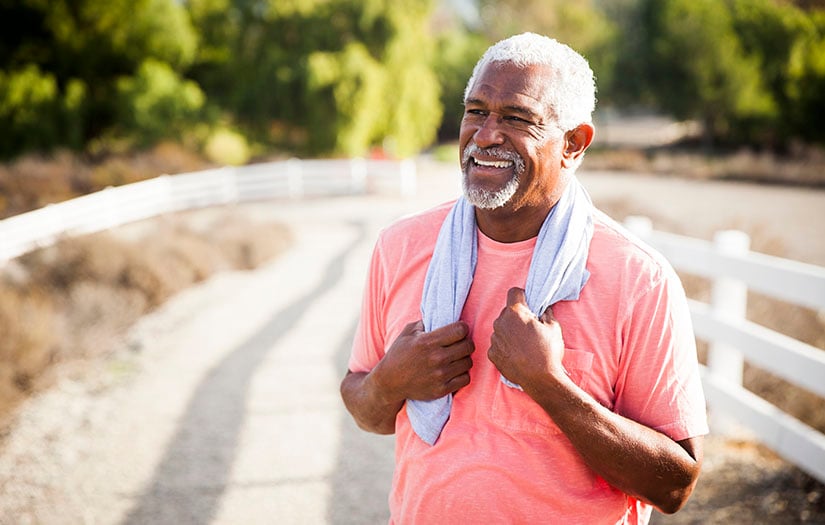According to the U.S. Census Bureau, there were over 54 million adults aged 65 and older in the U.S. in 2021, and the number is projected to continue to rise over the next 30 years. Staying physically active is incredibly important for this demographic to promote healthy aging.
Physical activity (including cardio and strength training) can help reduce chronic disease, prevent injuries, reduce falls, improve cognition and quality of life, decrease cardiovascular risk factors, improve muscle performance, and increase active life expectancy.
As fitness professionals, we have an incredible opportunity to not only help our senior clients improve their overall health and well-being through exercise but also to empower them to find activities that they enjoy doing to maintain a healthy and active lifestyle. Not sure what type of exercise to have them do or where to begin? We’ve got some ideas for you.
The information in this blog post complements the NASM Fitness Specialization Consider. Check it out for more information.
Types of Workouts for Seniors
Current physical activity guidelines recommend that seniors get at least 150 minutes to 300 minutes per week of moderate-intensity exercise or 75 minutes to 150 minutes a week of vigorous-intensity exercise or an equivalent combination of both moderate- and vigorous-intensity exercise.
As part of this recommendation, older adults are encouraged to follow an exercise program that includes balance training, cardio, and resistance training. If they are not healthy enough to get at least 150 minutes/week, they are still encouraged to do as much as they can tolerate. It’s also important to note that it’s never too late to start!
Choosing the right workout schedule for your senior client can be as simple as following the FITTE-VP principle:
• Frequency: 2 to 5 days per week.
• Intensity: As noted above, moderate-intensity or vigorous-intensity exercise is recommended. Intensity is relative to the individual.
• Time: Working up to 30-60 minutes per session.
• Type: Always think safety first! Strength training, balance work, walking, recumbent bikes, aquatics, treadmills, or stair steppers with hand support are all great options.
• Enjoyment: Find something they like to do!
• Volume: The total amount of recommended physical activity per week is 150 minutes or more of moderate-intensity activity, or 75 minutes or more of vigorous-intensity activity each week.
• Progression: Progress exercise volume systematically over time, up to 300 minutes per week of moderate-intensity activity or up to 100 minutes per week of vigorous-intensity activity, increasing at no more than 10% per week.
Importance of Cardio for Seniors
Cardio training can help senior clients combat age-related cardiovascular risk factors. Benefits of doing cardio include:
• Improved cardiac health.
• Lowered resting heart rate.
• Improvements in resting blood pressure.
• Improved blood pressure response to activity.
• Improved glucose metabolism.
• Improved blood glucose levels.
• Improved body composition (increased muscle mass, increased bone mineral density, decreased body fat).
Strength Training Exercises for Seniors
Resistance training is extremely beneficial for older adults because it improves muscle strength, decreases fat-free mass, and increases bone density. Additionally, resistance training helps to correct postural imbalances and reduce the incidence of falls or serious injuries if a fall does occur. Overall, resistance training can improve the health and quality of life of an older adult.
The focus of the strength training program should always be based on the client’s goals and assessments. If the client simply wants to improve or maintain their health and function, you can emphasize movements that mimic Activities of Daily Living (ADLs): squatting, hip hinge, pushing, pulling, and pressing. Below are examples of the simplest form of each movement. You can progress each of these as is appropriate for your client.
Squatting, which mimics sitting down and standing up.
Exercise to try: The sit to stand.
• Try this exercise without holding on to anything if possible.
• Find a sturdy chair or box at a height that you can get into and out of without holding on.
• Stand with your feet hip-width apart, close to the chair.
• Slowly sit down into the chair, keeping good posture in your back (chest lifted, shoulders back, and spine straight).
• As soon as your rear end touches the seat, stand back up, squeezing the glutes as you do.
Hip hinge, which mimics bending and lifting, especially a load that’s close to the ground (a popular maneuver for grandparents!).
Exercise to try a bodyweight hip hinge.
• Stand with your feet hip-width apart and place your palms on your thighs.
• Keep your back flat as you hinge forward, letting your hands slide down your thigh toward your knees.
• Go as far as your hips let you go without rounding your back. A slight bend in the knee is ok!
• Squeeze the glutes and drive the hips forward as you return to the standing position.
Pushing motion, which mimics being able to push open a heavy door or push oneself up should there be a fall.
Exercise to try Wall push-ups.
• Stand with your arms straight out and hands against a wall positioned slightly below shoulder height.
• Step your feet back until you are slightly angled forward, with your weight in your hands. Your body should be in a straight line from your head down to your toes.
• Brace your abs and glutes and bend your elbows to lower toward the wall. Your elbows should be pointed 45 degrees down.
• Exhale as you press away from the wall to the starting position.
Pulling motion, which mimics pulling open a heavy door or doing yard work like raking.
Exercise to try: Band Rows.
• Anchor a band to a sturdy base (like a stair banister or using a door attachment).
• Stand and hold the handles of the band while facing the anchor with your feet hip-width apart, knees slightly bent, and palms facing inward.
• Brace your core and keep your shoulders down as you pull the band straight back.
• Squeeze the shoulder blades together as you pull the wrist toward the ribcage.
• Slowly return to the starting position.
Pressing mimics putting your bags in an overhead container on an airplane or placing something up on a shelf.
Exercise to try: the Shoulder press. (This move is only appropriate for clients who demonstrate pain-free, full ROM when lifting arms overhead).
• Start with light weights or a household object like a soup can or water bottle in each hand.
• With your palms facing inward, hold the object at your shoulders, and brace your core as you press the weight straight up toward the ceiling.
• Slowly lower the weight toward the starting position.
These exercises can be programmed circuit-style, performing one right after another, to elevate the heart rate for some added cardio.
Programming note: A well-rounded program will also include flexibility, balance, and core work as part of the extended warm-up. Always begin training with Phase 1: Stabilization Endurance Training to build a strong foundation of good movement before progressing to more advanced styles of lifting.
Aerobic Exercises for Seniors
It’s perfectly fine to think outside the box when considering cardio options for your senior client. The main goal is for the client to reach the appropriate intensity level in the activity to increase their heart rate and respiratory rate sufficiently.
A great way to gauge the intensity level of an activity is to use the Talk Test to ensure that your client is training in the moderate- or vigorous-intensity range, whichever is most appropriate for your client’s goals and fitness level. Have your client choose an activity that they enjoy meeting the physical activity guidelines for cardio training. Here are some ideas:
• Circuit strength training.
• Walking on a treadmill.
• Stationary or recumbent bike.
• Aqua aerobics.
• Swimming.
• Dancing.
• Gardening.
• Sports like tennis or basketball.
• Combined strength training + cardio ntervals (such as riding a recumbent bike for some time between circuits).
Summary
A well-rounded workout program that combines strength training, cardio, balance, and flexibility will help your senior client stay healthy and improve their quality of life. Use the FITTE-VP principle and keep movements as functional as possible to help your client thrive both inside and outside of the gym. For a more in-depth look at senior fitness, check out NASM’s Senior Fitness Specialization.
References:
Lucett, S., Payne, A., Sutton, B. (n.d.). Senior Fitness Specialist. National Academy of Sports Medicine.
U.S. Department of Health and Human Services. (2018). Physical activity guidelines for Americans, 2nd edition. https://health.gov/sites/default/files/2019-09/Physical_Activity_Guidelines_2nd_edition.pdf

















